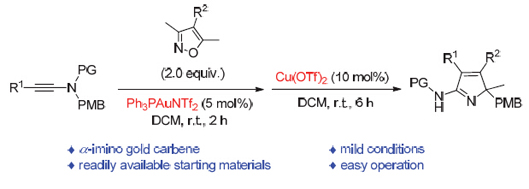| [1] For recent reviews, see: (a) Estévez, V.; Villacampa, M.; Menéndez, J. C. Chem. Soc. Rev. 2014, 43, 4633.
(b) Rane, R.; Sahu, N.; Shah, C.; Karpoormath, R. Curr. Top. Med. Chem. 2014, 14, 253.
(c) Young, I. S.; Thornton, P. D.; Thompson, A. Nat. Prod. Rep. 2010, 27, 1801.
(d) Thirumalairajan, S.; Pearce, B. M.; Thompson, A. Chem. Commun. 2010, 46, 1797.
(e) Fan, H.; Peng, J.; Hamann, M. T.; Hu, J.-F. Chem. Rev. 2008, 108, 264.
(f) Weinreb, S. M. Nat. Prod. Rep. 2007, 24, 931.
[2] (a) Roos, K.; Viklund, J.; Meuller, J.; Kaspersson, K.; Svensson, M. J. Chem. Inf. Model. 2014, 54, 818.
(b) Minidis, A.; Rahm, F.; Viklund, J. PCT Int. Appl. WO 2013054108A1, 2013.
(c) Chow, K.; Gil, D. W.; Donello, J. E.; Wang, L.; Corpuz, E. G.; Fang, W. K.; Sinha, S. C.; Dibas, M. I. PCT Int. Appl. WO 2011044229A1, 2011.
(d) Saito, S.; Takaaki, K.; Kobayashi, J. Tetrahedron Lett. 2007, 48, 5693.
[3] For recent examples on the synthesis of 2H-pyrroles, see: (a) Zhuo, C.-X.; Cheng, Q.; Liu, W.-B.; Zhao, Q.; You, S.-L. Angew. Chem. Int. Ed. 2015, 54, 8475.
(b) Zhou, Y.; Zhuo, C.-X.; Gu, Q.; You, S.-L. Adv. Synth. Catal. 2015, 357, 912.
(c) Zhuo, C.-X.; Zhou, Y.; You, S.-L. J. Am. Chem. Soc. 2014, 136, 6590.
(d) Lin, J.; Cheng, Y.; Kang, T.; He, L.; Liu, Q. Chin. J. Org. Chem. 2014, 34, 735. (林敬, 程宇, 康泰然, 何龙, 刘全忠, 有机化学, 2014, 34, 735).
(e) Zhuo, C.-X.; Liu, W.-B.; Wu, Q.-F.; You, S.-L. Chem. Sci. 2012, 3, 205.
(f) Ghavtadze, N.; Fröhlich, R.; Würthwein, E.-U. Eur. J. Org. Chem. 2008, 3656.
(g) Cai, C.-J.; Hu, B.-C.; Lu, C.-X. Chin. J. Org. Chem. 2005, 25, 1311. (蔡超君, 胡炳成, 吕春绪, 有机化学, 2005, 25, 1311).
[4] For recent reviews on ynamide reactivity, see: (a) Wang, X.-N.; Yeom, H.-S.; Fang, L.-C.; He, S.; Ma, Z.-X.; Kedrowski, B. L.; Hsung, R. P. Acc. Chem. Res. 2014, 47, 560.
(b) DeKorver, K. A.; Li, H.; Lohse, A. G.; Hayashi, R.; Lu, Z.; Zhang, Y.; Hsung, R. P. Chem. Rev. 2010, 110, 5064.
(c) Evano, G.; Coste, A.; Jouvin, K. Angew. Chem. Int. Ed. 2010, 49, 2840.
[5] For our recent study on the ynamide chemistry, see: (a) Shen, C.-H.; Pan, Y.; Yu, Y.-F.; Wang, Z.-S.; He, W.; Li, T.; Ye, L.-W. J. Organomet. Chem. 2015, 795, 63.
(b) Shu, C.; Wang, Y.-H.; Zhou, B.; Li, X.-L.; Ping, Y.-F.; Lu, X.; Ye, L.-W. J. Am. Chem. Soc. 2015, 137, 9567.
(c) Li, L.; Zhou, B.; Wang, Y.-H.; Shu, C.; Pan, Y.-F.; Lu, X.; Ye, L.-W. Angew. Chem. Int. Ed. 2015, 54, 8245.
(d) Li, L.; Zhou, B.; Ye, L.-W. Chin. J. Org. Chem. 2015, 35, 655. (李龙, 周波, 叶龙武, 有机化学, 2015, 35, 655).
(e) Li, L.; Shu, C.; Zhou, B.; Yu, Y.-F.; Xiao, X.-Y.; Ye, L.-W. Chem. Sci. 2014, 5, 4057.
(f) Pan, F.; Liu, S.; Shu, C.; Lin, R.-K.; Yu, Y.-F.; Zhou, J.-M.; Ye, L.-W. Chem. Commun. 2014, 50, 10726.
(g) Shen, C.-H.; Li, L.; Zhang, W.; Liu, S.; Shu, C.; Xie, Y.-E.; Yu, Y.-F.; Ye, L.-W. J. Org. Chem. 2014, 79, 9313.
[6] (a) Xiao, X.-Y.; Zhou, A.-H.; Shu, C.; Pan, F.; Li, T.; Ye, L.-W. Chem. Asian J. 2015, 10, 1854.
(b) Zhou, A.-H.; He, Q.; Shu, C.; Yu, Y.-F.; Liu, S.; Zhao, T.; Zhang, W.; Lu, X.; Ye, L.-W. Chem. Sci. 2015, 6, 1265.
[7] For recent selected reviews on gold carbene chemistry, see: (a) Qian, D.; Zhang, J. Chem. Soc. Rev. 2015, 44, 677.
(b) Wang, Y.; Muratore, M. E.; Echavarren, A. M. Chem. Eur. J. 2015, 21, 7332.
(c) Yeom, H.-S.; Shin, S. Acc. Chem. Res. 2014, 47, 966.
(d) Fensterbank, L.; Malacria, M. Acc. Chem. Res. 2014, 47, 953.
(e) Obradors, C.; Echavarren, A. M. Acc. Chem. Res. 2014, 47, 902.
(f) Zhang, L. Acc. Chem. Res. 2014, 47, 877.
(g) Hashmi, A. S. K. Acc. Chem. Res. 2014, 47, 864.
(h) Obradors, C.; Echavarren, A. M. Chem. Commun. 2014, 50, 16.
(i) Zhang, Y.; Luo, S.; Zhu, C. Chin. J. Org. Chem. 2012, 32, 2073. (张艳, 罗莎, 朱成建, 有机化学,2012, 32, 2073).
(j) Xiao, J.; Li, X. Angew. Chem. Int. Ed. 2011, 50, 7226.
(k) Hashmi, A. S. K. Angew. Chem. Int. Ed. 2010, 49, 5232.
(l) Luo, P.; Tang, R.; Zhong, P.; Li, J. Chin. J. Org. Chem. 2009, 29, 1924. (罗培松, 汤日元, 钟平, 李金恒, 有机化学, 2009, 29, 1924).
[8] For selected examples on the generation of α-imino gold carbenes, see: (a) Li, N.; Wang, T.-Y.; Gong, L.-Z.; Zhang, L. Chem. Eur. J. 2015, 21, 3585.
(b) Zhu, L.; Yu, Y.; Mao, Z.; Huang, X. Org. Lett. 2015, 17, 30.
(c) Prechter, A.; Henrion, G.; dit Bel, P. F.; Gagosz, F. Angew. Chem. Int. Ed. 2014, 53, 4959.
(d) Garzón, M.; Davies, P. W. Org. Lett. 2014, 16, 4850.
(e) Tokimizu, Y.; Oishi, S.; Fujii, N.; Ohno, H. Org. Lett. 2014, 16, 3138.
(f) Gronnier, C.; Boissonnat, G.; Gagosz, F. Org. Lett. 2013, 15, 4234.
(g) Chatzopoulou, E.; Davies, P. W.; Chem. Commun. 2013, 49, 8617.
(h) Yan, Z.-Y.; Xiao, Y.; Zhang, L. Angew. Chem. Int. Ed. 2012, 51, 8624.
(i) Xiao, Y.; Zhang, L. Org. Lett. 2012, 14, 4662.
(j) Davies, P. W.; Cremonesi, A.; Dumitrescu, L. Angew. Chem. Int. Ed. 2011, 50, 8931.
(k) Lu, B.; Luo, Y.; Liu, L.; Ye, L.; Wang, Y.; Zhang, L. Angew. Chem. Int. Ed. 2011, 50, 8358.
(l) Wetzel, A.; Gagosz, F. Angew. Chem. Int. Ed. 2011, 50, 7354.
(m) Li, C.; Zhang, L. Org. Lett. 2011, 13, 1738.
(n) Gorin, D. J.; Davis, N. R.; Toste, F. D. J. Am. Chem. Soc. 2005, 127, 11260.
[9] For a review on the combination of Au/acid catalysis, see: Zhang, S.; Wei, F.; Song, C.; Jia, J.; Xu, Z. Chin. J. Chem. 2014, 32, 937. |
